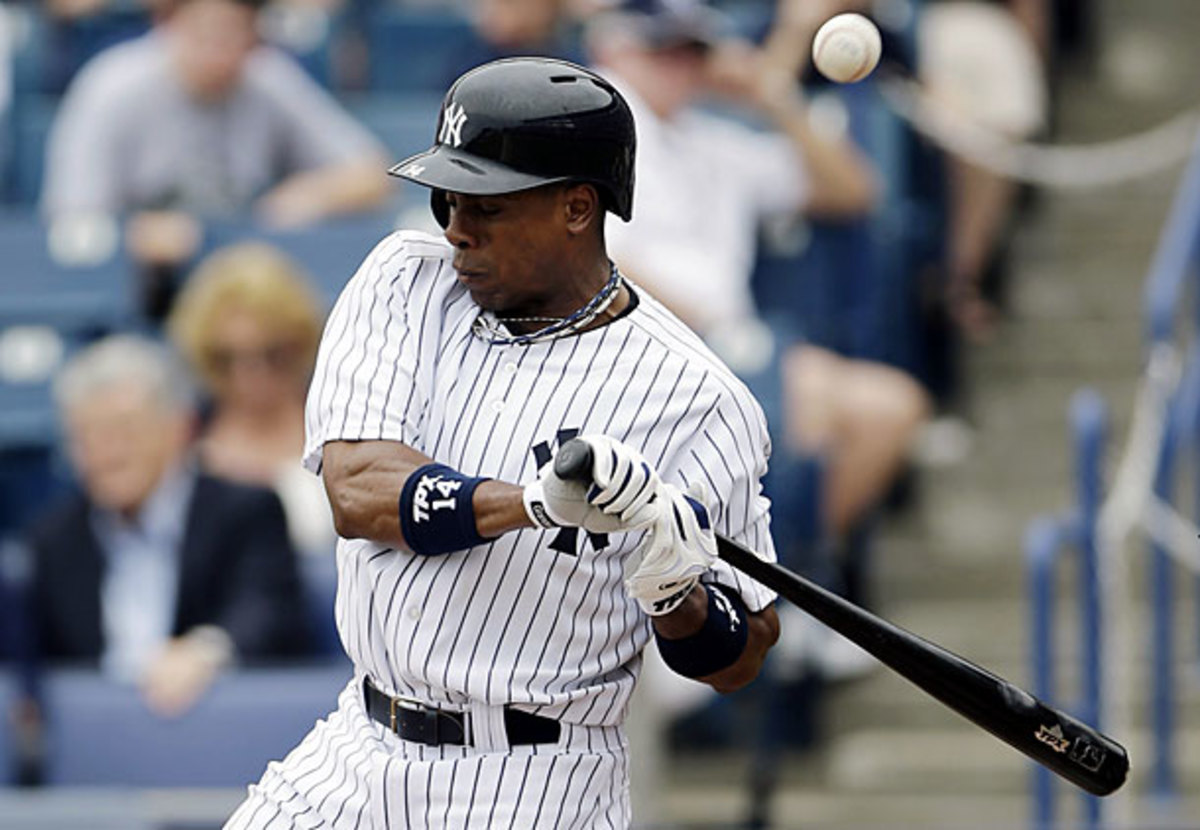
Curtis Granderson is back, but which version are Yankees getting?
Curtis Granderson broke his left forearm in his first spring training at-bat. (AP)
As expected, the Yankees have activated Curtis Granderson. After missing the first 38 games of the season due to a broken right forerarm sustained on his first plate appearance of the Grapefruit League season, he will make his 2013 debut batting fourth and playing leftfield against the Mariners on Tuesday night.
At 24-14 and in first place in the AL East, the Yankees haven't missed him quite as much as expected, but with more than half their intended starting lineup on the disabled list, their offense has been slightly worse than the league average at 4.32 runs per game. Granderson was expected to miss 10 weeks after being hit by an errant J.A. Happ pitch on Feb. 24, which would have meant a return on May 5. The 32-year-old outfielder didn't quite beat that timetable, but his rehab stint was short and sweet, as he went 8-for-20 with a homer in five games for Triple-A Scranton/Wilkes-Barre before his activation.
Granderson is playing leftfield because after two years in center, the team has conceded that Brett Gardner is the more effective flychaser, and moved him to his natural position, centerfield. Out of fears that the two outfielders wouldn't have time to work together at their new stations during spring training, the Yankees initially nixed that plan, but reversed course just in time for the rehab stint, which saw Granderson play left- and rightfield two games apiece while DHing in one. Granderson has 107 games of minor league experience in left, but just 22 such games in the majors. His three professsional games of experience in rightfield are all in the minors, but his recent spot duty there is intended to give manager Joe Girardi maximum flexibility in configuring his outfield on a given day.
Concerns about how Girardi would fit Granderson into an outfield picture featuring Gardner, Ichiro Suzuki and hot-hitting fill-in Vernon Wells have been eased for the moment — but only because of the Yankees' latest injury concern. Designated hitter Travis Hafner has been dealing with soreness in his right shoulder, which required surgery following the 2008 season and sent him to the disabled list in each of the following two seasons; he'll undergo an MRI sometime in the near future, and could sit for a spell. Wells is in the lineup as the DH on Tuesday night, with Suzuki in rightfield. Even if Hafner's injury turns out to be minor, it's worth remembering that with so many old and injury-prone players, the Yankees — now without Mark Teixeira, Derek Jeter, Alex Rodriguez, Francisco Cervelli, Eduardo Nunez and Kevin Youkilis — probably don't need to fret too much about how to divide up the playing time. The able-bodied will play, and the injured won't be rushed back.
The bigger question for the Yankees is which Granderson they're getting. Will it be the 2011 model who hit .262/.364/.552 and placed fourth in the AL MVP voting, or the 2012 one who hit .232/.319/.492? The latter had slightly more homers but far more strikeouts and fewer unintentional walks — not to mention fewer steals — in about the same number of plate appearances:
Year | PA | HR | SB | UIBB | SO | AVG | OBP | SLG |
2011 | 691 | 41 | 25 | 85 | 169 | .262 | .364 | .552 |
2012 | 684 | 43 | 10 | 71 | 195 | .232 | .319 | .492 |
What happened? The lefty-swinging Granderson saw a substantial drop in his batting average on balls in play against righties, from .290 to .259; that took a bite out of his production, from .258/.372/.531 in 472 PA to .239/.328/.511 in 437 PA. The bigger problem was the erosion of his performance against lefties, which had improved so dramatically via his work with hitting coach Kevin Long in late 2010 and early 2011; he sank from .272/.347/.597 in 219 PA against southpaws to .218/.304/458 in 247 PA, with his BABIP falling from .305 to .262 and his strikeout rate shooting from 27 percent to 32 percent.
Granderson is still an above-average contributor with the bat, but the offensive bar is higher at left or rightfield than it is in center. Then again, given the negative assessments of his recent work in center — between 16 and 23 runs below average in 2011-2012 according to the major defensive metrics, he may wind up more valuable in a corner when it's all said and done.



































